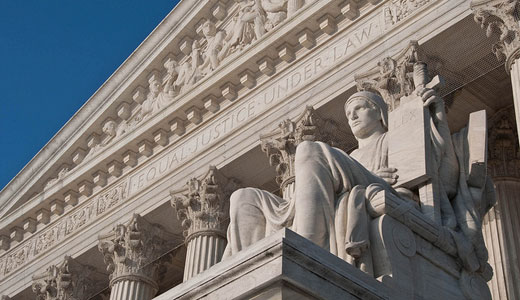
For millions of Americans who are suffocating under the weight of a protracted economic crisis, the makeup of the U.S. Supreme Court may not register as a priority, or even as a passing concern.
A job, a living wage, mortgage assistance, or relief from racial harassment probably rank much higher. And that is perfectly understandable.
Jobs are scarce; wages are stagnant; homes are being lost; and racial profiling is commonplace.
Nevertheless, who sits on the U.S. Supreme Court does matter and not only to legal scholars, but to ordinary Americans.
Indeed, the court, through its rulings, can impact either very positively or very negatively on people’s struggles and lives.
The present Supreme Court, according to one study, is the most conservative since at least the 1930s. Of the 10 most conservative members of the court from 1937 to 2006, five are serving today: Clarence Thomas (1 on the most conservative list), Antonin Scalia (3), John Roberts (4), Samuel Alito (5), and Anthony Kennedy (10).
Talk about a “rogues’ gallery.”
Ironically (and ominously), Kennedy is considered a moderate swing vote on today’s High Court, which not only indicates how far the court has shifted to the right, but also how far to the right Thomas, Scalia, Roberts and Alito (the “gang of four”) are. In fact, to characterize them as “right-wing extremists” may not adequately capture how far out they sit on the political and judicial spectrum.
Worse still, in the coming years the Supreme Court will be ruling on cases that could either considerably enhance or seriously hollow out democracy and the quality of life for tens of millions.
First up is the constitutionality of President Obama’s main legislative achievement – health care reform. According to court observers who monitored the hearings, the likelihood of an adverse ruling is high.
Then – not necessarily in this order – the court will turn its attention to the affirmative action program at the University of Texas that allows for race to be considered as one factor among many others in the university’s admission’s process. It will also reach a judgment on the legality of Proposition 8 which banned gay marriage in California, and on the Defense of Marriage Act. It will render as well a decision on section 5 of the 1965 Voting Rights Act which compels states that are enacting new voting rights laws to clear them with the federal government to ensure that they aren’t discriminatory in their impact.
The court will also listen to a legal challenge to Montana’s ban on corporate campaign contributions in election campaigns, and to a case involving the indefinite detention of “enemy combatants.”
Finally, the court may well hear challenges to Roe v. Wade as well as other broadly accepted precedents in American jurisprudence and democratic rights law.
Any Mitt Romney additions to the Supreme Court would almost certainly guarantee a series of adverse decisions on these and other legal matters over the next four years and beyond.
More fundamentally, with the likelihood of the retirement of some justices – the liberal Justice Ruth Bader Ginsberg being the first, a Romney presidency would be the vehicle to consolidate and make impenetrable the power of the extreme right in the judicial branch of government.
If you have any doubts about this, if you entertain the hope that Romney would nominate someone who occupies the judicial center, bear in mind two things.
First, the pressure on Romney from social conservatives – not to mention sections of corporate capital – to appoint “one of their own” to the court would be enormous. Both see the judiciary as an essential instrumentality for imposing a right-wing, socially conservative agenda.
Second, the chairman of Romney’s Justice Advisory Committee is none other than Robert Bork.
Some readers may be too young to have heard of Bork. So a little political biography might be helpful. Bork was solicitor general in 1973 and, at the command of then-President Richard Nixon, fired Archibald Cox as special prosecutor in the Watergate scandal, hoping to aid the Watergate coverup.
Later Ronald Reagan nominated him to the Supreme Court, but the Senate, in a bitter fight, rejected him by a vote of 58-42, the largest margin in history.
While the vote reflected a partisan divide, the grounds for rejecting Bork were substantive. He was on the wrong side of many settled judicial issues. He opposed broad protection for free speech; he questioned the constitutional right to privacy; he vigorously opposed integration of public accommodations, calling it “unsurpassed ugliness” – to name but a few of his more noxious views.
Since leaving the federal bench he has been a champion of ultra-conservative causes.
Here we have another compelling reason why the 2012 elections matter. While we don’t know who President Obama would nominate to the court if he is re-elected in November, we do know from his earlier appointments that they would in all probability fall on the democratic side of the political and judicial equation.
Photo: “The Guardian” or “Authority of Law” statue by James Earle Frasier in front of the U.S. Supreme Court building in Washington. Mark Fischer // CC 2.0










